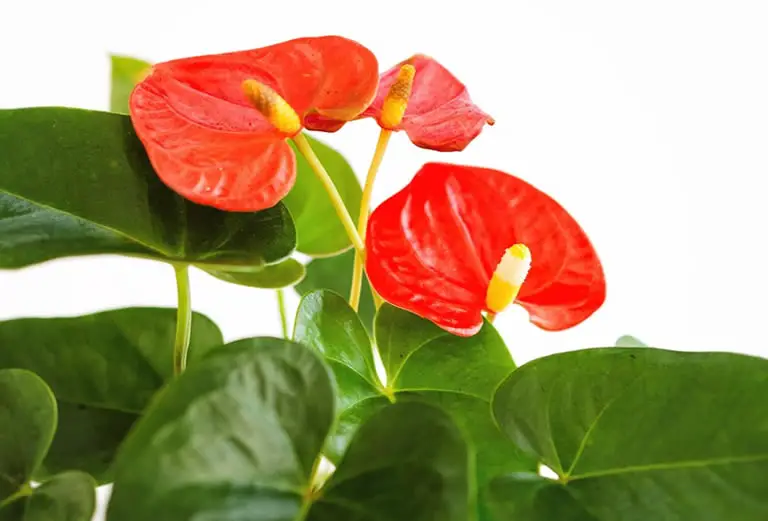The Anthurium includes nearly 1,000 flowering plant species. This appealing houseplant, that’s also called the laceleaf , the flamingo flower and the tailflower has earned those nicknames due to the bright coloring of its spathes.
If you’re interested in adding an anthurium species to your indoor garden, it is important you know how to properly care for it s this plant is truly unique in that respect.
Table of Contents
- ANTHURIUM CARE GUIDE – THE ESSENTIAL CARE REQUIREMENTS OF THE LACELEAF
- 6 ANTHURIUM CARE REQUIREMENTS YOU MUST GET RIGHT
- 1. Anthurium soil must be well draining
- 2. Your Anthurium watering routine must be 100% correct
- 3. Anthurium light requirements must be observed or your plant will not bloom
- 4. Ensure your Anthurium is placed somewhere with the correct temperature range
- 5. Anthurium loves humidity, so you have to create some
- 6. Only use the right kind of fertilizer for Anthurium
- 5 COMMON ANTHURIUM PROBLEMS & THEIR FIXES
- Root rot is a serious problem that will be fatal for a plant that is not treated immediately
- Black nose disease spreads easily & affects the foliage
- Pythium can lead to leaf yellowing & dead foliage
- Bacterial wilt is an aggressively spreading bacteria that must be eliminated
- Bacterial blight causes unsightly & harmful lesions on the plant
- 4 EXTREMELY POPULAR ANTHURIUM PLANTS THAT GROW GREAT INDOORS
ANTHURIUM CARE GUIDE – THE ESSENTIAL CARE REQUIREMENTS OF THE LACELEAF
Below is a quick guide to anthurium care for easy future reference.
You may find it helpful to return to this bullet list once you begin cultivating anthurium in your home.
However, I urge you to read through the entire article now so that you understand exactly what each point is referring to.
How to care for Anthurium indoors – quick 6 step overview
Here’s how to care for an anthurium indoor
- Always use a coarse soil mixture composed of potting mix and perlite (or similar) at a rate of 1:1.
- Water the anthurium only when the upper half of the soil dries out.
- Choose a spot that gets 5 hours of bright, strong indirect light.
- Set temperatures between 65 and 80 degrees Fahrenheit.
- Keep humidity over 50%.
- Fertilize monthly with during growing season with an orchid liquid fertilizer but dilute the mix to half strength.
This guide to anthurium care will elaborate on each point above so you can create a solid routine that sets up your anthurium to grow and thrive.
A quick overview of the Anthurium plant
Before we look at the care requirements of Anthurium lets take a look at exactly what this plant is.
Anthurium is a genus of over 1000 epiphyte flowering herbs. It is an evergreen plant. Anthurium is also known by the names tailflower, flamingo flower and laceleaf. It blooms by producing colored spathes.
Anthurium is native to parts of the Americas and grows widely in Mexico, some parts of the Caribbean and Northern Argentina.
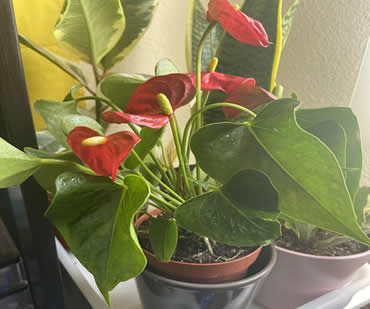
Most anthurium species are epiphytes. Epiphytes (like anthurium, the Hindu rope plant and dracaena) are plants that grow on other plants rather than growing directly in the ground.
Although some species of anthurium are terrestrial, growing in the ground, the popular anthurium houseplants are all epiphytes and therefore require very specific care.
Ending the confusion between Anthurium plants and succulents
After discovering the main care requirements of Anthurium, many houseplant owners wonder if this plant is actually a succulent.
Anthurium is not a succulent. However, it does share some similar care requirements to a succulent such as its watering needs.
Let’s take a look at the care requirements of anthurium in more detail.
6 ANTHURIUM CARE REQUIREMENTS YOU MUST GET RIGHT
Whether you like the big and bright colors of the Anthurium Purple Flamingo flower or the deep waxy red of the Anthurium Red, or the crinkled edges of the Anthurium Ruffles, you’re definitely onto a winner with this stunning plant as it makes a great houseplant.
Below are the care requirements of the anthurium in full.
1. Anthurium soil must be well draining
The first step to a good care routine for any plant is to ensure it is being cultivate din the correct soil. Honestly, you would be shocked by the amount of problems that are caused with houseplants across the country from simply using an incorrect soil.
So, what soil does anthurium need?
Anthurium needs a coarse rich potting mix that is fast draining. Although standard potting mix will give the plant all the nutrients and minerals it needs, it does not provide the drainage and airflow that is essential for anthurium.
Therefore mixing one part potting mix to one part perlite makes the best soil for anthurium.
To reiterate, standard houseplant potting soil is not appropriate for use with anthurium. And, although the watering of anthurium is more similar to that of a succulent than a standard houseplant, anthurium should not be potted in succulent soil either.
Because most anthurium species are epiphytes (plants that rely on other plants to grow) and are usually found growing in the crevices of trees, their roots have evolved to need more airflow than the average terrestrial plant that grows in the ground.
So Anthurium plants need a soil that promotes good airflow when they are grown as potted plants.
Anthurium react poorly to sitting in water-drenched soil, or even soil that is just overly moist, and so they require a good and fast draining soil.
As you will, presumably, not be growing your anthurium on a tree and will be instead potting it, you will need to use a special soil mix.
In order to ensure your plant gets enough nutrients, but also has good airflow to the roots and the least amount of moisture retention in its soil, you will need to mix standard potting soil with other ingredients.
Potting mix should be mixed with either perlite or vermiculite or oak bark, at a ratio of 1 to 1, i.e. half potting mix and half perlite or half potting mix and half vermiculite or half potting mix and half oak bark.
The addition of perlite, or a similar material, helps to aerate the soil allowing for better airflow and fast water drainage.
2. Your Anthurium watering routine must be 100% correct
Incorrect watering can lead to some serious problems with your plant. Problems that can be fata (as you will lean later).
You must ensure your watering routing is 100% on point.
How often you should water anthurium
The anthurium prefers that you allow its soil to dry out considerably between waterings.
For most anthurium you should only water the plant when 50% of the soil has dried out. For Anthurium Big and Bold you must wait until at least 75% of the soil has dried out before watering.
For almost all popular anthurium houseplants, at the very least about 50 percent of the plant’s upper part of the soil should be dry before you water it.
However, if you’re caring for an Anthurium Big and Bold, then you’re free to allow up to 75 percent of the soil to dry out before you water your plant.
Many people wonder how they are supposed to know when the soil is dry that far down in the pot. Well, there are two ways to determine the moisture level in the soil.
The first method involves a slight alteration of the popular finger test that I have mentioned many times throughout my guides on this website.
You follow the same procedure, as laid down here, except you must push your finger much further down into the soil. Please only use clean hands for this, as you don’t want to accidentally contaminate the soil.
What should you look for?
Dry soil doesn’t have much, if any, moisture and so your finger will come out with very little, to no, debris on it. If it comes out caked in dirt then the soil has plenty of moisture in it.
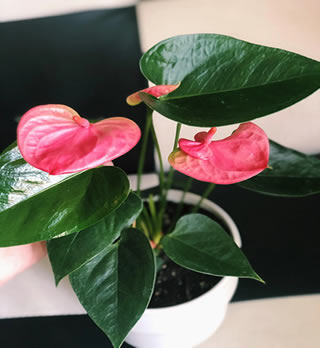
The second method for testing soil moisture, and the more accurate way (especially for unseasoned gardeners), is to use a simple cheap moisture meter. Make sure you push the meter well into the soil so you get an accurate reading.
Gauge how far you should push the meter down by comparing the height of the meter with the height of the pot on the outside of the pot. Place a bit of colored tape at the point on the meter that is roughly half way down the pot. Then you’ll know how far to push the meter in.
When the meter reads dry, it’s time to water the plant.
How to water anthurium the right way
When the time comes to water your anthurium, fill a watering can and pour the water into the plant pot and keep pouring. The water should flow out of the pot’s drainage holes at the bottom (your pot does have drainage holes, right?) before you stop watering.
Be sure that once you notice that water is flowing from the pot’s drainage holes, you stop watering the plant immediately.
It is best to water your anthurium plant in a sink as you will need to ensure the pot drains fully of excess water.
If you only use a saucer or tray to catch the excess water then you run the very real risk of the water accumulating underneath the plant. Anthurium will die in standing water!
If you’re not familiar with the concept of standing water, standing water is when water accumulates in the soil with no exit point (usually when the pot doesn’t have proper drainage) or in the tray/saucer underneath the plant after it has been watered.
Leaving the plant in standing water is quite serious, as it can lead to root rot. This is a fungal disease that we’ll talk more about later, but know that it can kill any houseplant, the anthurium included (more on this later).
Overwatering an anthurium has the same effect as leaving the plant in standing water.
Be aware though that it is just as bad to underwater your anthurium as it is to overwater it.
Depriving an anthurium of water can induce stress in the plant as well as causing the obvious dehydration. The leaves will become brown and crispy. Some leaf yellowing could occur as well.
Water is also essential for delivering nutrients to the outer foliage of the plant and therefore insufficient moisture in the soil means a lack of nutrients to the whole plant.
Remember, in anthurium species such as the Anthurium Red, the Anthurium Pink, and the Anthurium Big and Bold, those “flowers” aren’t like typical plant flowers at all.
Each flower is a single bract that surrounds a spike and they require the same nutrients and hydration as the leaves surrounding them.
As plant foliage relies heavily on hydration you don’t want those spathes or leaves becoming brittle or discolored due to underwatering.
And, once the leaves dry out, you’ll have no choice but to remove the dead bits. That can sometimes require you to cut off entire leaves, including the colorful spathes.
3. Anthurium light requirements must be observed or your plant will not bloom
Always keep your anthurium away from direct sunlight.
The best type of light for this houseplant is bright, indirect light.
Let’s talk a bit about what type of indirect light anthurium needs and how you should supply the plant with it.
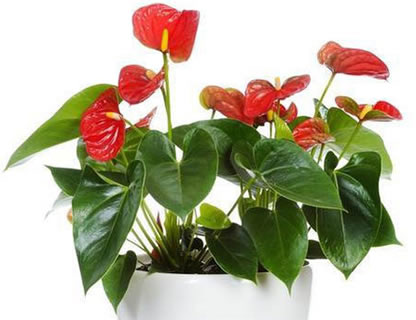
The best type of indirect light for an anthurium is the type that passes through something that filters the light a little.
A large sheer curtain hanging on a bright window, or even another larger houseplant positioned correctly, will offer anthurium enough protection against the strong UV rays that come with direct light. Yet. this slight blockage will still allow the plant to get plenty of indirect light for photosynthesis.
You can place your anthurium anywhere in a well-lit room as long as the plant is located away from any sun-facing windows or areas that get hit with direct sunlight.
I personally like to keep an anthurium in the corner of my kitchen as it is a well-lit area that does not receive excessive direct sunlight.
A word of caution: be very careful with the light that the plant is exposed to as anthurium reacts poorly when overly exposed.
You’ll know if your anthurium needs relocated due to too much light when the leaves turn white, almost as if they’ve been bleached. The foliage may also display spots that can turn brown and dry.
Leaf wilting can also occur due to incorrect light conditions, and plant growth will stop as well.
As was the case with overwatering or underwatering your anthurium, you’ll have no choice but to prune the dead parts of the plant if it suffers from incorrect light issues. Your anthurium just won’t look the same without its colorful spathes.
How much light your anthurium needs to thrive
So now you now what type of light anthurium needs you’ll want to know how much of it is needed per day.
Anthurium needs about 3 – 5 hours of strong indirect light per day. Although the plant can easily handle more light than this, less light will stunt plant growth and limit, or even fully restrict, blooming.
An anthurium that’s receiving at least 3 hours of bright, indirect light per day will grow steadily and should produce more spathes. However, I aim to ensure my anthurium get a minimum of 5 hours of good indirect light per day as I find they develop better and produce more colorful blooms.
It is possible to grow anthurium in low light under strict conditions
A question I often get asked by houseplant owners is if it is possible to cultivate a healthy anthurium in low light conditions?
You can grow anthurium in low light but if you want your plant to produces colorful spathes (blooms), then I you must give it a minimum of 3 hours of strong indirect light per day. 5 hours of strong indirect light per day will produce better blooms.
Many houseplants can grow in dim lighting and shade. The anthurium genus is among them. However, it will never bloom in low light conditions. Your plant will survive, but you’re not going to see a lot of growth out of it.
You certainly should not expect to see any colorful “blooms” if you grow your anthurium away from good, strong indirect light.
4. Ensure your Anthurium is placed somewhere with the correct temperature range
The anthurium genus is a native to tropical areas of the Americas. It grows from the Caribbean to northern Argentina and northern Mexico. So, it should come as no surprise that the plant likes warm temperatures.
The anthurium does best in temperatures between 65°F and 80°F.
The typical room temperature range for an American home is between 68°F and 72°F, with the average temperature being 70°F, so you shouldn’t have to touch your thermostat when growing the anthurium if you live in a normal US home.
That said, you don’t want to get too lax when it comes to localized temperatures around your plant. In temperatures below 60°F your anthurium will suffer from cold shock.
A cold-stressed plant can quickly develop black spots across its foliage. These are areas where the cells have frozen and probably ruptured.
Once these black spots develop, they’ll never turn green gain, so you’ll have to trim them off. The same goes for the colorful spathes.
Your anthurium will also stop growing in cold temperatures and its foliage will begin to droop. The leaves can even fall off.
Although an anthurium is accustomed to warm regions it doesn’t have much tolerance for high temperatures any more than it does for cold temperatures Temperatures over 90°F will also damage the plant.
When it gets too hot, the plant can fall victim to heat stress, which is just as detrimental to it as cold shock. Your anthurium will wilt and its leaves will also become dry and browned as if you underwatered the plant or exposed it to bright light.
5. Anthurium loves humidity, so you have to create some
In an anthurium’s natural habitat of the Caribbean and Mexico, the air is quite humid so you need to replicate those same conditions for the anthurium when growing it at home.
The anthurium prefers at least 50% relative humidity.
The average amount of humidity in a building is usually below 30% so although the temperature range of a typical American home is ideal for anthurium the humidity levels are not.
You might not be able to provide enough humidity for your anthurium without taking the measures outlined below.
You can mist your plant with warm water and a spray bottle every day but this is the least effective method for raising and maintaining humidity levels for long periods. As the water mist falls to the floor the humidity levels return to normal.
As anthurium does not like to sit in water adding a water and pebble filled tray underneath the plant is also not ideal.
The two best methods for maintaining higher humidity levels directly around the plant involve using a terracotta pot (which wicks moisture from the soil to the outside of the pot for evaporation into the air) and/or by using a cheap plant humidifier (like this one).
Without enough humidity, the anthurium’s gorgeous foliage can dry out and you can lose those lovely colorful spathes much too quickly.
6. Only use the right kind of fertilizer for Anthurium
Fertilizer is, obviously, plant food but unlike humans who can all survive on the same type of foods plants have different nutritional needs.
Anthurium grows best with a 3-2-1 fertilizer that has higher levels of nitrogen than normal houseplant feeds. Orchid feed also works well with anthurium.
Just be sure that whatever feed you use, you only use it at half strength.
It is important to get a plant feed that is not only loaded with the exact nutrients and minerals needed for anthurium but that also contains the correct macronutrients such as nitrogen, phosphorus, and potassium. These nutrients support everything from chlorophyll production to the strength of the plant walls.
Oh, and macronutrients make it possible for a n anthurium to photosynthesize, which is how it gets the energy to develop new branches and offshoots and develop those colorful spathes.
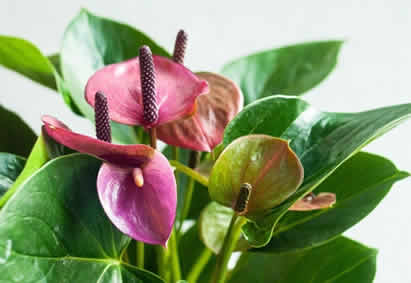
When Anthurium should be fertilized to encourage growth & flowering
So now that you understand the importance of using nitrogen-rich feed, when should you use it?
The anthurium enters its active growing season in the spring through the end of the summer and it is at this time that the plant should be fertilized.
Once per month during the growing season, feed the plant liquid fertilizer mixed to half strength.
You can use a standard fertilizer that has been formulated for indoor plants though I prefer to use an orchid feed as it has higher levels of nitrogen. If you can find a formula that’s made just for anthuriums, that’s even better though.
Whatever feed you choose bear in mind that an anthurium-friendly liquid fertilizer should contain more nitrogen than phosphorus or potassium.
Dilute whatever fertilizer you choose to about half-strength.
Although it’s tempting to fertilize the anthurium more frequently than once per month, I’d strongly recommend you refrain from doing so. Plants can suffer from fertilizer burn when they’re fed too much. All those nutrients and minerals in such large quantities can become damaging for the anthurium leading to leaf burn and causing your plant to look sickly.
If you do over-fertilize the plant you will have to flush the soil from the anthurium’s pot and may even need to repot it with fresh soil.
No anthurium care guide is complete without addressing the potential problems that can arise from giving the plant the wrong care. So, this leads me to the more upsetting elements of caring for anthurium – dealing with anthurium problems due to incorrect care.
5 COMMON ANTHURIUM PROBLEMS & THEIR FIXES
Growing your anthurium isn’t always a walk in the park. Even small mistakes in your care routine can lead to big problems further down the line if they aren’t fixed.
I have addressed the most common problems encountered with anthurium houseplants due to incorrect care routines and have also included their fixes below.
Root rot is a serious problem that will be fatal for a plant that is not treated immediately
Root rot is one of the most serious problems a houseplant can face. Although it is more prevalent with succulents any houseplant can suffer from it.
Root rot is caused by a fungal disease which is almost always due to overwatering by the plant owner.
We touched on root rot before, both its causes and its fix, in the article about aloe vera root rot, and I often cite that article when talking about succulents. However, as anthurium has similar watering needs to succulents reading the aforementioned article is advised as the information is very appropriate for this plant.
So what is root rot?
All plants need equal measures of water and oxygen to survive. When standing water accumulates in a plant’s pot, the water chokes out the roots. Oxygen cannot reach the roots and they slowly drown in the water.
As the roots die, they become brown or black. Their firm texture turns mushy. They are then unable to absorb moisture from the soil to distribute to the rest of the plant. The plant literally dies of dehydration in a mass of water.
The smell of dying roots is one that’s difficult to miss, especially in a severe case of root rot. And a bad smell from your plant is usually a tell-tale sign that rot at the root level has taken hold of the plant.
However, do not rely solely on smell to identify this problem. A withering of the foliage when the soil is moist is another clear sign of root rot. The plant will look visibly dehydrated, brittle and sickly.
Root rot, as we mentioned before, is caused primarily by overwatering your plant. If you’re watering your anthurium every day or even every other day and you don’t live in a extremely hot region, then you’re watering the plant too much.
In some instances, compacted soil can cause root rot.
In such a case the water is unable to penetrate the soil deep enough to drain away and accumulates at the root level. Although a potential cause for root rot compacted soil is much less common in anthurium than overwatering because of the perlite in the soil.
Houseplants with root rot, such as an anthurium, are possibly savable but you must act quickly at the first sign of this problem.
First you must remove your anthurium from its pot so you can assess its root ball. Then you need to cut away every dead or dying root you see, leaving only the healthy white roots intact.
Be sure to sterilize your pruning shears using an alcohol wipe between each snip and when you’re finished. If you don’t, you could accidentally spread the fungus to healthy roots and later spread it elsewhere in your indoor garden!
Clean the pot, and once dried, fill it with fresh, dry soil. Ideally use a new pot and dispose of the old one after you have cleaned it!
Place your plant back where it belongs and moisten the soil but do not water it completely. Be sure to limit how often you water your houseplant moving forward.
If the root system is strong enough with just the remaining roots, then your anthurium can survive root rot. However, if all that’s left are a few stragglers, then the plant will likely not survive.
Black nose disease spreads easily & affects the foliage
Colletotrichum gloeosporioides is a fungus that causes black nose disease in the anthurium. An infected plant will sustain damage across its faux flowers.
In especially warm and humid conditions, black nose disease will spread easily.
Plants that have experienced bacterial blight (more on this disease momentarily) or those that have been damaged by overfertilization are especially at risk of black nose disease.
The symptoms include spots across the faux flowers of the anthurium. These spots can grow quickly in size. The spots start off brown but become black, and they develop a watery texture as well.
The spots eventually take over the spadix (flowering spike) fully, possibly causing this part of the anthurium to shed.
You’ll have to use a good fungicide to control black nose disease in your anthurium.
Pythium can lead to leaf yellowing & dead foliage
From fungus to pathogens, pythium is an oomycete that’s parasitic in nature. Oomycetes are like a fungus but are technically microorganisms.
Pythium and another pathogen like it, called phytophthora, are known as water molds since standing water accelerates their development.
The symptoms that an anthurium may manifest include root death or leaf chlorosis (leaf yellowing), wilting, and sometimes brown or black lesions.
The only treatments for pythium and other oomycetes are to reduce the frequency of your watering while also using a fungicide. You may also want to repot your plant in fresh dry soil.
Bacterial wilt is an aggressively spreading bacteria that must be eliminated
Ralstonia solanacearum is a strain of bacteria that can cause bacterial wilt in an anthurium.
This bacteria can get deep into the soil and sometimes live for years even after the original plant that the bacteria infected is long since dead.
The hotter the temperatures, the likelier bacterial wilt is to occur. If you use the same soil for another plant, even though that plant wasn’t originally infected, the bacterial wilt will spread.
You must decontaminate or throw away anything, and everything, that touched the infected anthurium recently.
You can also try a phosphoric acid-based fungicide even though bacterial wilt is actually a bacterial plant disease.
Bacterial blight causes unsightly & harmful lesions on the plant
Bacterial blight can afflict anthurium species as well. The Xanthomonas axonopodis bacteria cultivates the spread of disease.
Aroid plants such as dumb canes, peace lilies, and aglaonema in close proximity to anthurium might make the anthurium likelier to develop bacterial blight.
Standing water can also contribute to this disease, as can wet foliage.
An anthurium with bacterial blight will have lesions that look saturated with water. The lesions become bigger, forming sharp Vs, and causing dead spots across the anthurium’s foliage.
Be sure to manage humidity and watering to limit the spread of bacterial blight. Increase air circulation as well.
You’ll have no choice but to remove the infested plant from your indoor garden permanently when this problem occurs.
4 EXTREMELY POPULAR ANTHURIUM PLANTS THAT GROW GREAT INDOORS
As we touched on in the intro, you have your pick of practically 1,000 anthurium species. Obviously covering all species is beyond the scope of this article. Instead I will touch on some very popular anthurium, all of which have similar care needs.
Below I will highlight four of the most popular anthurium that are grown as houseplants. The care requirements highlighted throughout this article all apply to these plants.
Anthurium Ruffles
The Anthurium Ruffles, botanical name Anthurium plowmanii, might lack the variegation that some indoor gardeners are attracted to when selecting houseplants, but it’s got something even better. Well, it is at least as good.
That something is … ruffles!
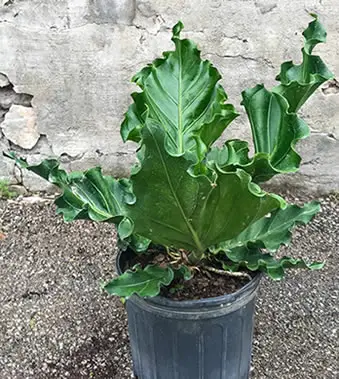
That’s right, all along the leaf edges of this large anthurium variety are wavy leaves that look just like ruffles.
The simple green coloration of the Anthurium Ruffles allows those ruffles to stand out that much more. This is one head-turning houseplant without a doubt.
Anthurium Red
Known also as the flamingo flower or Anthurium andraeanum, the Anthurium Red produces eye-catching bright reds across its foliage. It is arguably the most well-known anthurium.

The spathe of the plant has a waxy texture that is bright red. Its spadix or inflorescence looks like a candle holder and its reds are offset by a contrasting yellow hue.
Adding a pop of color to your indoor garden is easy when you have an Anthurium Red or two.
Anthurium Pink
A variation of the Anthurium Red is the Anthurium Pink.
Rather than develop spathes in bright red, the Anthurium Pink blooms are a pretty, creamy pink. The spadix can be yellow but may also sometimes appear red, green, or pinkish (or a mixture of some of those colors, as in the image below).
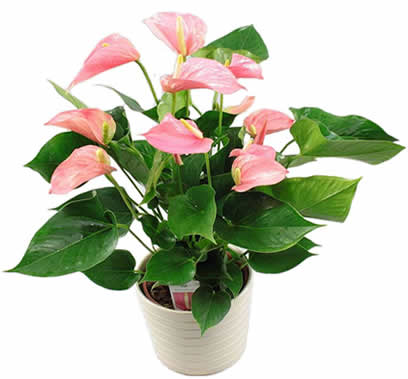
Whether you grow the Anthurium Pink on its own or in combination with the Anthurium Red, your indoor garden will be brilliantly colorful, that’s for sure. I particularly love the hue of this anthurium variation.
Anthurium Big and Bold
With a name like Big and Bold, you might expect a lot out of this anthurium species. Well, let us tell you that you won’t be disappointed.
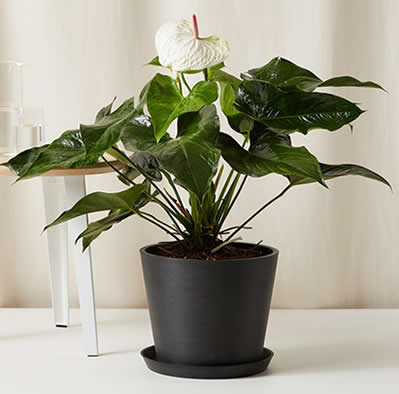
The Anthurium Big and Bold features white modified spathes. The spadix that stands tall and proud is a contrasting red for a truly unique effect among your houseplants.
It gets its name from the fact that you can grow the plant to quite a large size for floor use, rather than the table and shelf use where you usually find the other variations.
Conclusion
The anthurium is an appealing, colorful houseplant with faux flowers. Although its care isn’t overly simple, it shouldn’t be too difficult to care for your anthurium now that you know what to do.
Take care of your anthurium and it will live for up to 5 years without needed repotting.
We hope this care guide helps you grow beautiful anthuriums throughout your indoor garden!

